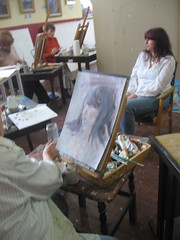Taste is a tough sense to convey in writing. It’s generally going to be confined to two basic usages: a character eating and a character tasting fear/blood/etc. Latter is a sensation that can be very powerful as a visceral response—unless it’s overused. Generally, it’s remembered fairly well.
 For the first example, we don’t want to spend too much time describing something we’re all familiar with. The taste of chicken? You’re probably better focusing on the spices or side dishes.
For the first example, we don’t want to spend too much time describing something we’re all familiar with. The taste of chicken? You’re probably better focusing on the spices or side dishes.
However, when a character is tasting something new and unfamiliar to them and your audience (chilled monkey brains!), describing that taste can help them experience this new food along with your character.
Taste testing your writing
Although taste is tricky to convey in writing, there are a number of ways to convey taste effectively in writing.
- Expand your flavor vocabulary. Sour, salty, bitter, sweet and spicy are a good start—but they’re awfully generic. That doesn’t mean we should hop straight to just naming garam masala or vegemite as the flavor, either. There’s a whole spectrum of common flavors out there—smoky, lemony, nutty, yeasty, buttery—that can serve as references.
- Use familiar references. Again, don’t just name an obscure flavor and hope your readers will get it. Some might, but if it’s important enough to name, it’s important enough to help your readers experience, right?
- Expand your actual palette. Take a cooking or tasting class, or host a tasting party of your own—cheese is usually a good place to start, since you can get several varieties in almost any grocery store. Invite over some friends, taste the cheeses, take notes and compare.
- Actually eat the food you’re describing. Even if it’s a familiar food, you might pick up on something to bring out your character or scene better with another taste.
- Remember texture. Like I said yesterday, texture is an important part of an eating experience. (And hey, temperature can be, too. Cold pizza vs. hot, anyone?)
- Consider the character. If this is a restaurant, what would s/he order? Why? (I like to use real restaurant menus as starting points, but you don’t have to.) Also, think about your character’s culture—was she raised on collard greens and KFC or colcannon and Abrakebabra? What flavors do they like, and is their flavor vocabulary, and how can you make sure that translates well to your audience?
- Empower emotions. Is there something about these flavors that triggers a memory or other reaction from the character? Does s/he like or dislike this taste?
Also, take into account your setting and genre. Culinary cozies, for example, will probably feature far more taste than fast-paced thrillers—unless those thrillers take place at Le Cordon Bleu.
What do you think? How do you convey taste in your writing?
Photo by Mike Burns



 Though she wasn’t “his” anymore, it was definitely Molly.
Though she wasn’t “his” anymore, it was definitely Molly.



